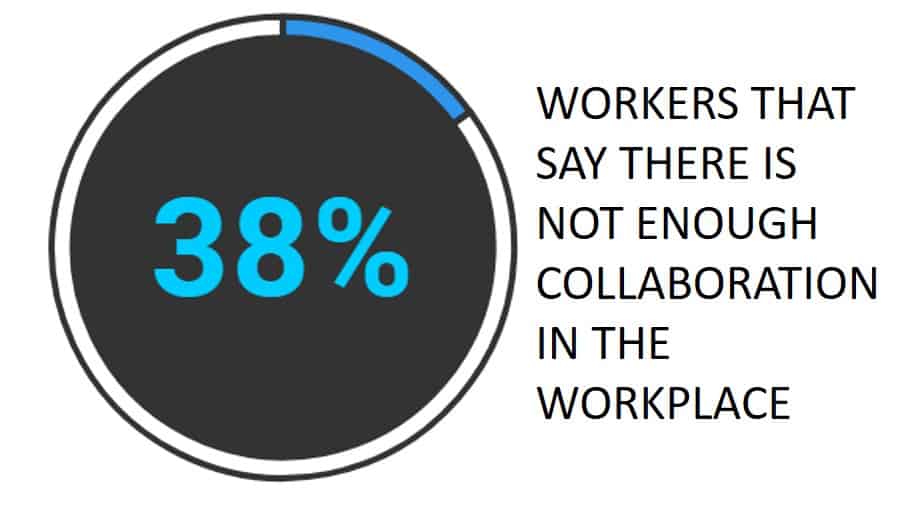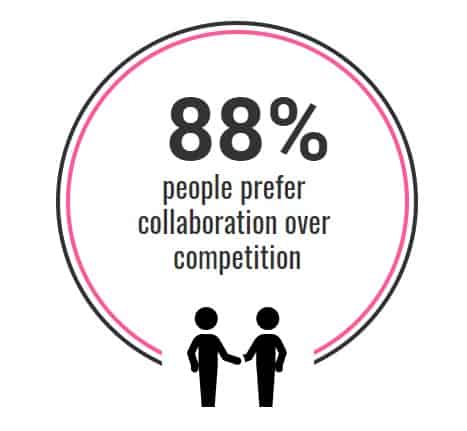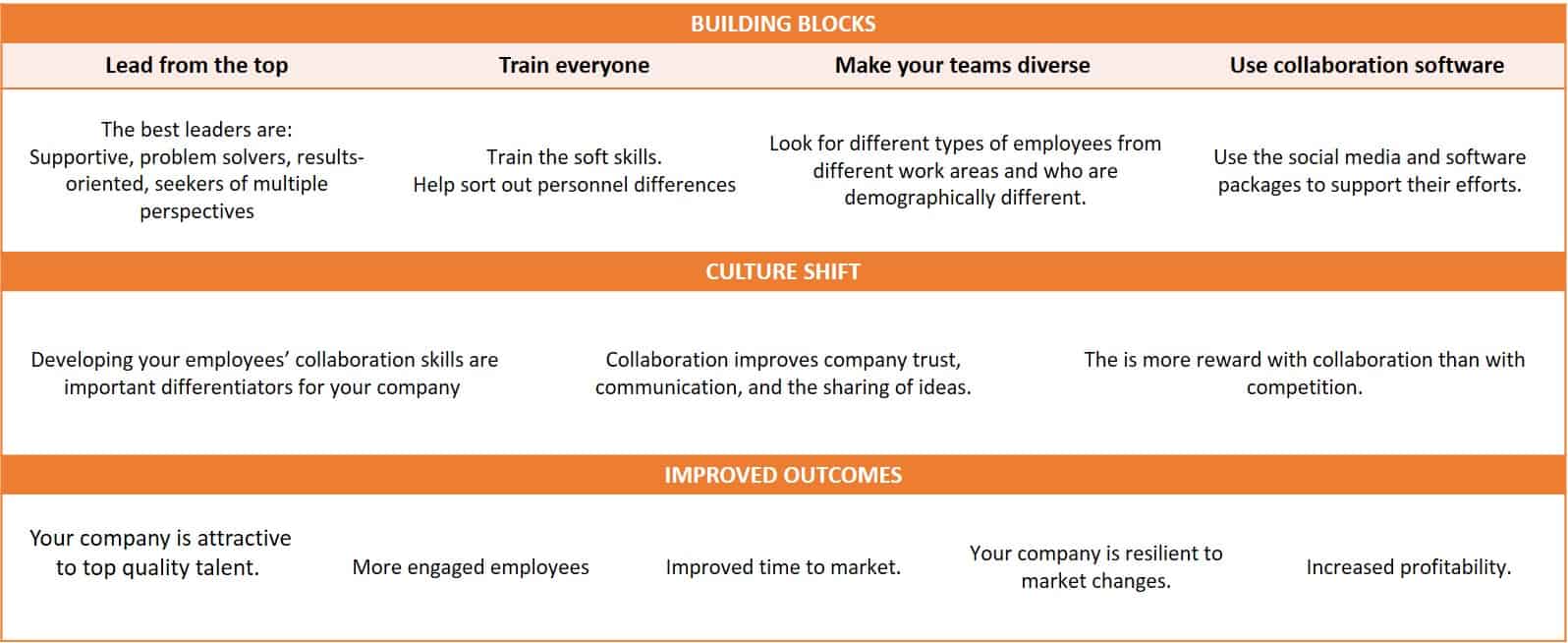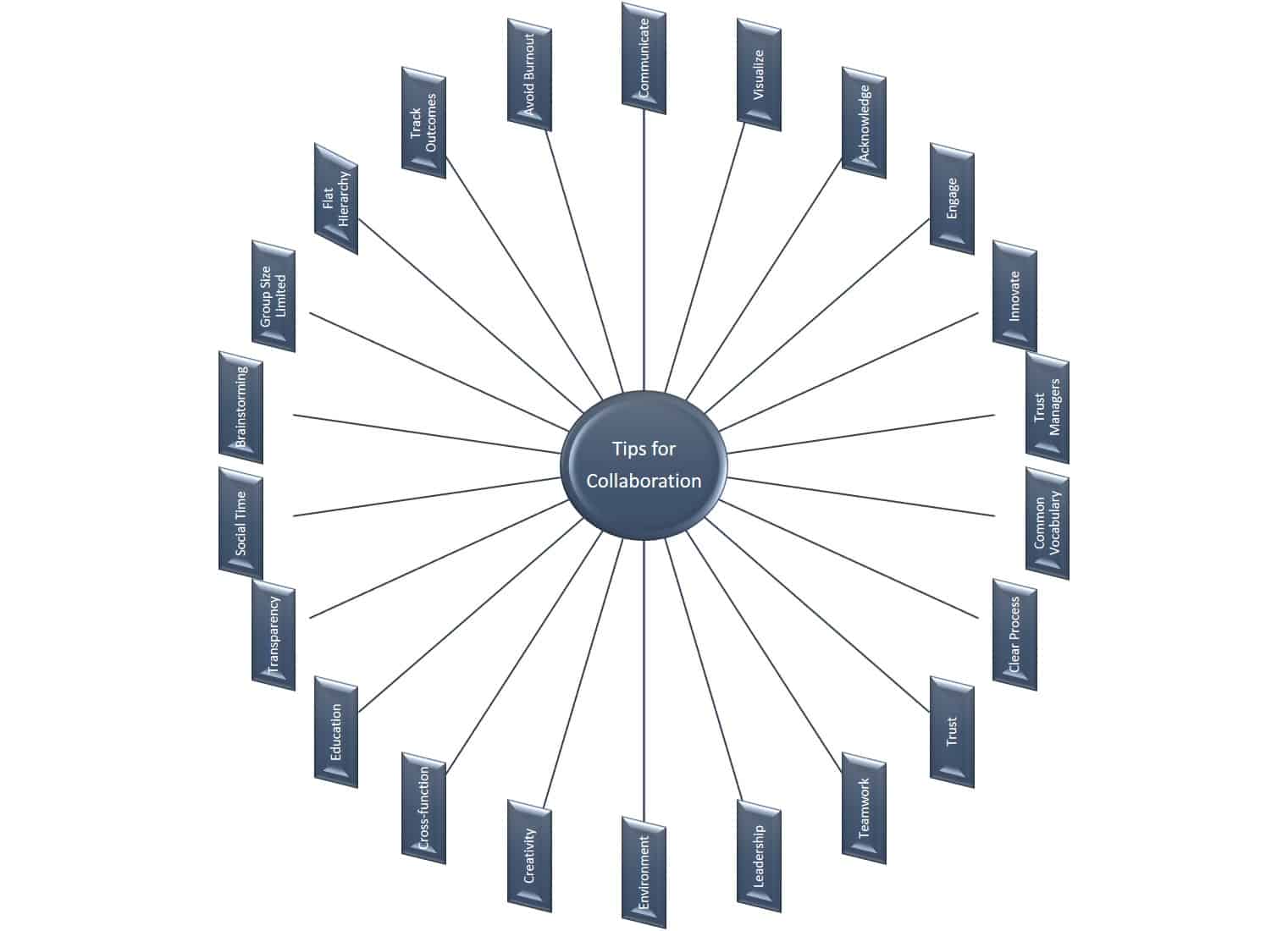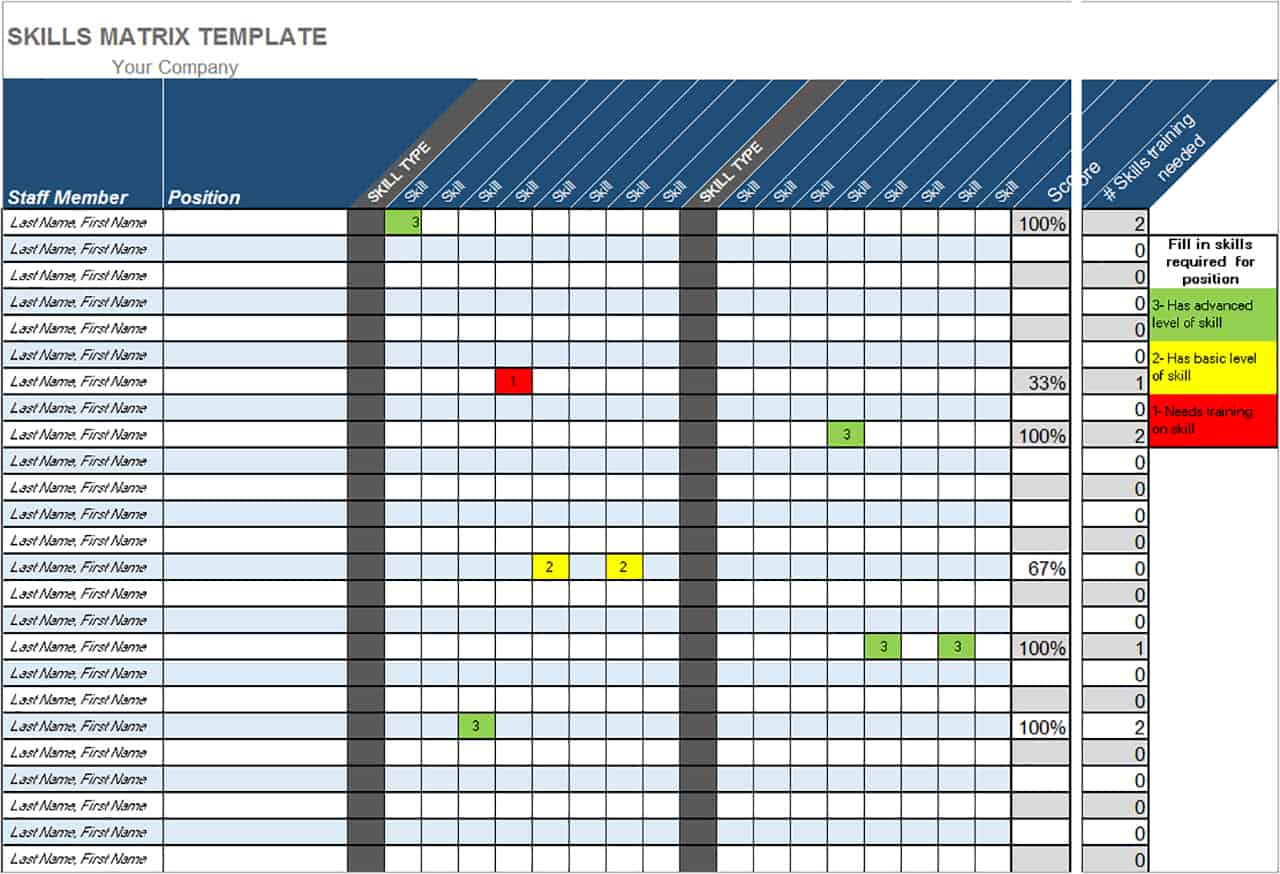What Is Collaboration in a Team?
People toss around the terms collaboration and teamwork quite often. Nevertheless, people are often uncertain about the exact meaning. You can have a collaboration, a team, a collaborative team, or collaboration that occurs within a team. These instances are all distinct, but for the purposes of our discussion, we will consider the overall intent, structure, skill sets, and goals of collaboration. You can perform almost any type of work collaboratively. If nothing else, collaboration can simply refer to the collective work of two people. Frequently, you will implement collaborations because each team or team member brings a specific resource that is necessary to achieve an end goal.
A collaboration can occur between units, departments, or companies. Collaborations are often temporary, and partners change with circumstances. Many collaborations arise because one person or group possesses a skill set or service that the other cannot provide. Generally, teams are the lowest group level with a shared purpose. Teams are units that often share the same or similar skills. Collaborative teams are units that bring together individuals with unique, disparate skill sets for a defined goal, and you assemble teams for particular collaborations because of their specific set of skills. Many collaborative teams work together frequently but can spin off to other projects and collaborations when necessary. Building collaboration into your teams allows team members to push each other to perform, give each other insights, and even help develop each other as professionals.
Collaborative working takes on a variety of forms:
- Different businesses that work together but maintain their independence
- Large organizations that assist smaller businesses
- Startups that use multiple partners for joint work on a project
- One large parent organization that oversees a group of subordinate organizations
- A merger that forms a new organization in order to work cohesively on activities
A collaborative working environment (CWE) is a work setup where professionals can work together regardless of their geographic location - people can telework or e-work instead of being collocated. A CWE is often virtual and takes advantage of technology, such as email, instant messaging, video conferencing, application sharing, collaborative workspaces, Wiki groups, or blogging. For more information on video conferencing, see “Keeping People Engaged and Making Them Excited to Attend Your Video Conference.”
These information and communication technology (ICT) environments and tools encourage collective work and the culture needed to support it. According to Forrester, “Tools should support the way people work.” Most workers see these cultures of collaboration as innovative and preferable to other types of workplace cultures. And, with the technologically savvy younger generations entering the workforce, business leaders are becoming even more enthusiastic about adopting a culture of collaboration. In fact, the majority of millennials prefer a collaborative working environment. Moreover, all 100 of the 2017 Fortune Best 100 Companies to Work For incorporate collaboration into their environment. Since millennials grew up with the internet, they expect to be connected and to use the technology that enables this connection. As they get older and their lives change, they will use this technology to support their work-life balance, and that balance includes e-working.
Along with technological prowess, empathy is a skill that relations to collaboration. Empathy is the ability to recognize and identify with other people’s emotions. It requires us to think beyond ourselves and be aware of the different realities and perceptions of others - those whom we accuse of selfishness or self-centeredness may be incapable of empathy. Many people consider empathy a soft skill or people skill that can either propel professionals or hold them back; regardless of your views on this, you must understand others in order to collaborate with them effectively. Studies show that managers who display empathy at work create a psychologically safe environment, which is the most important component of a successful team. Many of the world’s top companies, including Apple, cultivate empathy in their employees. You can still be a good leader while also displaying empathy for your staff.
The formal term for all of the working together that takes place in an organization is the collaborative work system (CWS). This unit develops any time collaboration takes place, regardless of the collaboration’s structure or intention. You base the potential and success of any CWS on how well your organization has developed its strategies, policies, and structures. These practices should provide the catalysts for working together well. Poorly designed infrastructure does not lead to strong collaboration and, in fact, can ultimately create more barriers.
CWE and CWS are related concepts: Your CWE is the foundation for your CWS. Your CWE should have cutting-edge technology and set the stage for your employees’ productivity, whether they are using portals, smartboards, interactive documents, or e-meetings. However, you can have all the technological bells and whistles and still fall flat if your CWS design isn’t solid. This system requires commitment to properly using your technology and environment. Furthermore, proper collaboration requires good facilitation. Good facilitation, in turn, requires developing soft skills, such as how to have productive conversations and resolve conflicts.
While collaboration is changing the face of the working environment, not all of this change is for the better. For example, the distribution of collaborative work is never even - you’ll find yourself calling on certain staff members repeatedly because of their skill sets and willingness to help, which makes them ripe for excess stress and burnout.
In fact, one employee who always goes the extra mile can drive performance more than all the other team members combined, according to a study by Li. This can be a vicious cycle for top collaborators: The more they collaborate, the more they perform. The more they perform, the more in demand they are, which ushers them into more collaboration roles. This cycle affects not only this top collaborator, who will eventually experience burnout and waning personal effectiveness, but the overall performance of your company, as projects get delayed waiting for that high performer to weigh in. Good managers, however, can learn how to redistribute the workload and protect these in-demand personnel. Managers should be aware of how much time their personnel spend in meetings and whether (and when) it is truly necessary for them to attend. Using this method, managers can identify the potential for collaborative overload and inefficiencies before they happen. They can also help determine whether your infrastructure needs to change. Perhaps you need more decision makers, more access to knowledge, or to reallocate certain job responsibilities.
How Did the Collaborative Working Environment Come About?
People have always needed to work together. Whether building pyramids or crushing grapes for wine, product development has always requied multiple hands and minds to come together. However, as technology and the internet have evolved, we have been able to work toward more collaborative models regardless of discipline and geographic location. Now, you can work virtually, making decisions with your partners about construction materials and getting a wine expert to mentor you on your fermentation.
Collaboration was not always favored in the workplace. In the past, the business landscape featured mostly those who got ahead due to their own individual efforts. Companies often favored competition, especially in certain fields, in order to drive professionals forward.
Recently though, leaders and organizations have begun to realize that even their employees’ best singular efforts could not match some of the elaborate problems we face. Now, the collective impact of a group of people can fix problems that we formerly believed were unsolvable. For example, under one city’s pilot program, the hospital systems, public health agency, and transportation services came together to help solve health care access issues and reshape healthcare service delivery in their area. These varied entities not only had to form a brain trust, which meant sharing ideas, but also had to share grant money and establish new procedures. Instead of competing against each other for the grant money and declaring health care access an impossible problem to solve, they worked together from different sides of the same problem.
With new technology, you don’t have to be as structured as in the past. Now, you have options. Here are three types of collaboration you can implement:
- Team Collaboration: In team collaboration, you define your parameters. You must spell out your tasks, resources, expectations, timelines, and goals. You know who your group members are, and everyone gets equal responsibility and compensation.
- Community Collaboration: In community collaboration, the goals are often more about learning or information gathering than about completing a task. Community collaboratives usually build their knowledge base by sharing information and giving advice to the community or the community’s partners. Some members of the collaborative may have more political capital, status, or power than other members. These types of collaborations can lead to smaller, project-focused groups.
- Network Collaboration: A network collaboration goes beyond both team and community collaborations. It is not about the relationships that develop in the course of normal collaboration, but about the accumulation of individuals who form a network. A network collaboration is a group of like-minded individuals who are interested in a specific topic. These networks are repositories of information now only possible with today’s social media tools.
What Is Collaboration Work System Software?
Collaborative software, also known as groupware, is software specifically designed for groups involved in common projects. Professionals design these applications as either real-time collaborative editing (RTCE) packages or as version control programs. RTCE programs enable several people to edit a computer document simultaneously, on different devices. Version control programs manage the changes you make to documents and other information, identify when you or someone else makes changes, and assign revision tracking. Users of version control software make parallel edits to their files and save multiple variants of a document. There are many different collaboration software programs, including free, open-source, and proprietary versions. Your team can use this software when they are in different physical locations or in the same room. This type of software allows everyone on your team to work on, review, and edit their cumulative documents without the extra work of tracking who is working on the documents at the same time. You can actually complete work instead of spending time scheduling who will be working on something.
What Does It Mean to Be Collaborative? How to Build a Culture of Collaboration?
Establishing collaboration in your workplace takes more than just declaring that you will collaborate. Some groups are used to working independently, and some are used to working in hierarchical teams. You must establish the procedures, protocols, and culture that will support effective collaboration. This means that your infrastructure and written guidelines support your intentions. Moreover, you must commit to this collaboration on a daily basis — especially at your highest levels. In performing these actions, you are developing loyalty, trust, and cooperation from the top down.
The following chart details how you go from the building blocks to the outcomes.
Following are other policies and actions that encourage a collaborative culture:
- Using cross-functional teams
- Establishing flexible working arrangements
- Implementing the latest technology
- Rewarding innovation
- Building virtual teams
- Using people’s differences
- Nurturing safety and trust
- Getting employee buy-in
- Developing open communications
- Empowering your staff
Some companies give daily open-communication updates to their staff to illustrate transparency. Some organizations encourage team members to share their personal lives. Whatever you choose to do to encourage a collaborative culture, your approach should inspire, inform, and engage your staff. Here are some additional ways to encourage a collaborative environment:
- Celebrating people’s personal events and lives
- Starting and maintaining company traditions
- Encouraging fun while you work
- Asking for every team member’s opinion
- Encouraging friendly work discourse
- Honoring individuals
What Are the Elements of a Successful Work Collaboration?
At this point, you know what collaboration is, that people want it, and some ways to implement and support it in your business. However, just because you have engaged with collaboration at the surface level does not mean that you are doing it successfully. The following elements will help lead you to successful collaboration:
- Defined Roles: Your team needs to lay out and agree upon the various roles in the partnership. The earlier you do this, the less strife you’ll experience.
- Open Communications Within Your Teams: Encourage and model communication skills so that everyone can share the information necessary to complete their tasks.
- Consensus about Goals and Methods: In the same way that you define the roles, you need your team to agree upon the project goals and how to meet these goals. Everyone can work differently, but they need to be working toward the same end.
- Obstacles Identified and Problems Addressed: If you clearly establish the roles and methods, you should be able to address issues as they arise. Before problems occur, your team needs to know their limitations.
- Group Goals Prioritized above Individual Goals: Everyone wants to be recognized and lauded for their contributions. Make your praise and appreciation group centric so that the message of group goals is consistent throughout the project.
- Ability to Apologize: Encourage and model behavior that makes your team members willing to apologize for their own gaffes and forgive others for mistakes.
The elements above are fairly basic. They encompass best practices and use common sense. If you talk to industry experts whose companies are fully remote, you will find that they require more advanced tactics, but you can still easily apply their lessons. One of the experts’ main strategies is to hire the best talent. If you hire the most talented people, regardless of their physical location, you will be successful not only in collaborative work, but in general. Here are approaches to more advanced problems concerning collaboration:
- Ping Each Other When You Need a Quick Chat: Rather than wasting time scheduling meetings, use your instant messaging apps when you need quick advice. Better yet, pick up the phone - if the person is busy at that moment, they will not answer. Some people send an email that asks the recipient to call them quickly when they get a second. This takes the place of popping over to your coworker’s office and potentially disrupting their productivity.
- Nix the Long Inline Emails: Inline emails - those that add onto previous emails with comments, perhaps in a different color, are confusing for everyone but the writer. Especially if someone is entering the conversation late, they have to work hard to figure out what is going on. Write well-crafted response emails. Bullet your points for clarity and call out action items for everyone.
- Use Video Chat When You Need to Connect: Some clients and staff members are difficult, and some simply do not pay attention on calls. If you find one of these are the case, try using video chatting to get their attention. Video chatting also forces people to behave more professionally because psychologically, people behave better when they watch themselves react. Make sure to use a person’s name before you ask them a question to ensure you have their attention.
- Use a Virtual Private Network: A VPN helps make your internet access “faster” in some respects. It also encrypts your traffic, speeding it up and giving you additional data security.
- Use Interactive Whiteboards: The new generation of whiteboards can save and export their content. Instead of delivering handouts or notes after a meeting, schedule the whiteboard to send email copies to meeting participants.
- Treat Collaborative Work Differently from Your Other Work: It may seem that work is work, and that you can manage all of your projects in the same way. Due to the flat hierarchy in collaborations though, your normal project management routine will not work the same way. Use software tools to update everyone’s status. This cuts out unnecessary meetings.
- Discuss Intellectual Property Rights Ahead of Time: Instead of fighting after the fact when something is developed, work out ahead of time and possible IP before it comes about.
- Have Structured Discussions, Not Brainstorming Meetings: Come with an initial plan and get your team to weigh in on it and improve it with their ideas. Outline clear deliverables beforehand, and structure discussions around a goal-oriented agenda. End meetings with the next steps for everyone defined.
All of these elements, ideas, and tactics should help you build a collaborative team. It also takes the commitment of your executives, human resources, team leaders, and of course, your employees. For more information on building collaborative teams, see “Collaboration Networks: Bringing Together a Team to Accomplish Your Projects.”
What Does It Mean to Be Collaborative at Work?
- Determine a collective vision with your company stakeholders.
- Provide the leadership to promote effective collaboration.
- Assess the strengths and weaknesses of partners.
- Expect transparency and accountability from everyone.
- Monitor and adjust your expectations.
- Listen to everyone with ideas.
- Invest the necessary time and energy in collaborative tasks.
- Provide the training to acquire collaboration skills.
- Determine the best ways to engage employees.
- Provide collaboration-related incentives, rewards, and benefits.
- Emphasize a work-life balance for employees.
- Develop a culture of trust within your company.
An operations manager should focus on the following activities to establish a collaborative environment:
- Identify the obstacles to success.
- Interview clients to determine their needs and preferences.
- Modify staff roles and processes to enhance efficiency and satisfaction among partners.
- Be open to new ideas about how to proceed based on your team's’ findings.
- Help select compatible partners to carry out projects.
- Report to your managers as needed.
- Listen actively to the concerns of team members.
- Agree on the roles that capitalize on your team members’ individual strengths.
- Analyze problems without assigning blame.
- Define mutually acceptable roles within the team.
- Delegate tasks with open discussion.
- Arrive at a consensus regarding goals and processes.
- Elicit the views of reluctant group members.
- Facilitate group discussion.
- Listen to the concerns of team members.
- Make sure you hear the perspectives of your quieter collaborators.
- Recognize and resolve conflicts with collaborators.
- Update collaborators on a project’s developments.
- Report to your managers as needed, especially when adjustments to the timeline or expectations are necessary.
- Be assertive within the group setting.
- Take part in brainstorming sessions to solve problems.
- Help build a consensus about the goals and processes for group projects.
- Compromise when necessary to move the group forward.
- Display a willingness to find solutions to problems.
- Follow through with commitments in a reliable manner.
- Forgive others when they come up short.
- Give credit to others for their contributions.
- Maintain a sense of humor and fun whenever possible.
- Meet deadlines for your individual contributions.
- Recognize the contributions of other collaborators.
- Recognize the strengths and weaknesses of collaborators.
- Be reliable within the group setting.
- Share feelings of frustration or dissatisfaction as they occur.
- Speak respectfully with team members.
- Take responsibility for mistakes.
- Work hard to fulfill obligations to the team.
Collaboration among Generations
For the first time in history, there are three or even four generations in the workplace at the same time. The generations may go by slightly different names and you may group them slightly differently (depending on your source), but they are:
- The Silents or Traditionalists: Born between 1925 and 1944
- The Baby Boomers: Born between 1945 and 1964
- Generation X: Born between 1965 and 1980
- Generation Y or the Millennials: Born between 1981 and 2000
There are many challenges to working with people from different generations, but each generation ultimately has something to learn from the other. (This is illustrated in the film The Intern, where a 70-year-old man takes a “Senior Internship” at a fashion startup, and begins working under a millenial CEO.)
As a group, each generation has its own unique values, attitudes, and experiences that they have cumulatively lived through. Of course, there is overlap between all of the generations, but some facets remain unique. For example, the Traditionalists lived through World War II, and have values that may be very Nationalistic, reflecting a time of great sacrifice in America that imbued a sense of national loyalty. However, Generation X, often also called the Sandwich generation, may have their parents and their children living with them at home, reflecting their status as caretakers for their Baby Boomers parents and their own children. They may be less nationalistic at this point, and more concerned for their own family’s well-being.
Older generations also generally came up in competition in the workplace. Collaboration is not about competing with your co-worker. Competition puts up silos and keeps companies from being agile. Therefore, while there are many skills that the older generations excel at, collaboration may not be the most natural.
These generational differences are a real concern to many companies. According to The Economist, companies still have many growing pains trying to figure out how to handle these differences, while training what they want in their employees. Experts agree that you should take into account the generation of the employee if you are looking to foster a collaborative environment.
The Benefits and Challenges of Collaborative Work Management
Collaborative work management is the formal way of referring to the style of management needed for handling collective work. Collaborative work managers need to be flexible, forward leaning, and tech-savvy. At the very least, they need to have an open mind in how to address new challenges. Some of the benefits of this style of management and collaboration include the following:
- Physical location does not matter.
- It is possible to have a central communication location.
- Increase visibility and transparency to keep stakeholders up to date.
- Save time by eliminating meetings and spreadsheet management.
- Be more agile in the face of changing demands.
- Inspire collaboration and innovation across the team.
- Reduce time to market.
- Increase innovation.
- Improve morale.
- Build agile new product development.
- Leveraging the power of information.
- Increase your team’s synergy.
- Decrease your business’ attrition rates.
Collaboration is not without challenges, though. Here are some of the most common obstacles to collaboration:
- Multitasking can reduce work quality.
- There may be extra costs in collaboration related to technology and long-distance relations.
- Deep work may be difficult to measure when you have people on multiple projects.
- According to Carl Wiese, “Bad collaboration is worse than no collaboration.”
Collaboration can also be difficult in the following scenarios:
- When you have unclear goals
- When you have a murky decision-making process
- When your team does not stick to your agreed-upon process
- When it is difficult to break down entrenched knowledge and silos
- When your team has a poor reputation
- When there are unclear or undeveloped rules of engagement
- When you have difficulty finding the right skill sets for your project
What Is a Collaborative Work Environment?
A collaborative work environment (CWE) is a space — whether that space consists of the physical design, the tools, or the culture — that supports collaboration. Research in this discipline usually concerns how we organize a company and space, what technology is available and which kinds you should use, and what social issues arise when people work together. Experts in the field of CWE recommend that you meet the following criteria:
- Design natural groupings within your physical space.
- Make communication easy.
- Address the areas between spas that are open but still private.
- Strike a balance between office-based and remote work.
- Consider privacy in two ways: via information and via stimulation.
- Take into account the differences that are inherent in different cultures.
These days, open offices are often met with backlash. Still, there are numerous benefits to transitioning to an open workspace. These environments can foster collaboration, learning, and a defined culture. Of course, workers still need a sense of separateness and privacy. For some, being alone is critical to focusing. The more demanding the work, the more people may need to be on their own. If you are struggling to find a balance between stimulation and information, consider the following strategies on both the individual and the organizational level.
Individual level strategies include the following:
- Strategic Anonymity: This strategy is about working in a place where you are unknown. For example, try a coffee shop across town from the office. Because no one knows you, no one will ask you for anything. Plus, a coffee house will supply pleasant, ambient background noise that doesn’t concern you directly.
- Selecting Exposure: You decide how much personal information you want to share with your coworkers. For example, when speaking with someone, you have the option of simply using the phone rather than video chatting.
- Assigned Confidence: If you are a manager, you need to be able to have private conversations with your team members. You must be able to create the space (e.g., a private room) for sensitive conversations.
- Purposeful Shielding and Solitude: In the same vein as private management conversations, people need to be able to have private personal calls, and occasionally work in a place where they can be alone and think. In this way, people are intentionally getting away from the open environment.
Here are some strategies for ensuring productivity on the organizational level:
- Protocols: Your organization can develop formal expectations for privacy. This can be specific to the department, time, or certain places. For example, some companies may want to designate quiet rooms where silence is the rule, and people can dock into a workstation or access Wi-Fi. Another idea is that your staff should perform all conference calls in a breakout or conference room to keep the extraneous talking down. Whatever your necessary protocols, you should clearly define them as well as the consequences for repeatedly neglecting them.
- Cultural Signals: Your personnel can decide what signals they want to send to their coworkers when they need to concentrate. Some people use bulky headphones or earbuds to signal their unavailability. Some actually put up a “do not disturb” sign on the back of their chair. Regardless of the method, your culture should support an employee’s occasional need to be left alone.
Your team members’ privacy and ability to collaborate depends on how you design your space. You can accommodate both collaboration and privacy needs by looking at either a distributed model or a zonal model. In the distributed model, you have different spaces in close proximity that support both privacy and collaboration. These spaces are close together but still separate and distinct from one another. The zonal model allows for more separation between the private and collaborative spaces. For example, you could have a floor that is uniformly quiet, and one that is completely open and bustling. Whichever type of model you develop, it should reflect your unique culture and ecosystem’s needs.
Improve Collaboration with Work Management in Smartsheet
Empower your people to go above and beyond with a flexible platform designed to match the needs of your team — and adapt as those needs change.
The Smartsheet platform makes it easy to plan, capture, manage, and report on work from anywhere, helping your team be more effective and get more done. Report on key metrics and get real-time visibility into work as it happens with roll-up reports, dashboards, and automated workflows built to keep your team connected and informed.
When teams have clarity into the work getting done, there’s no telling how much more they can accomplish in the same amount of time. Try Smartsheet for free, today.
